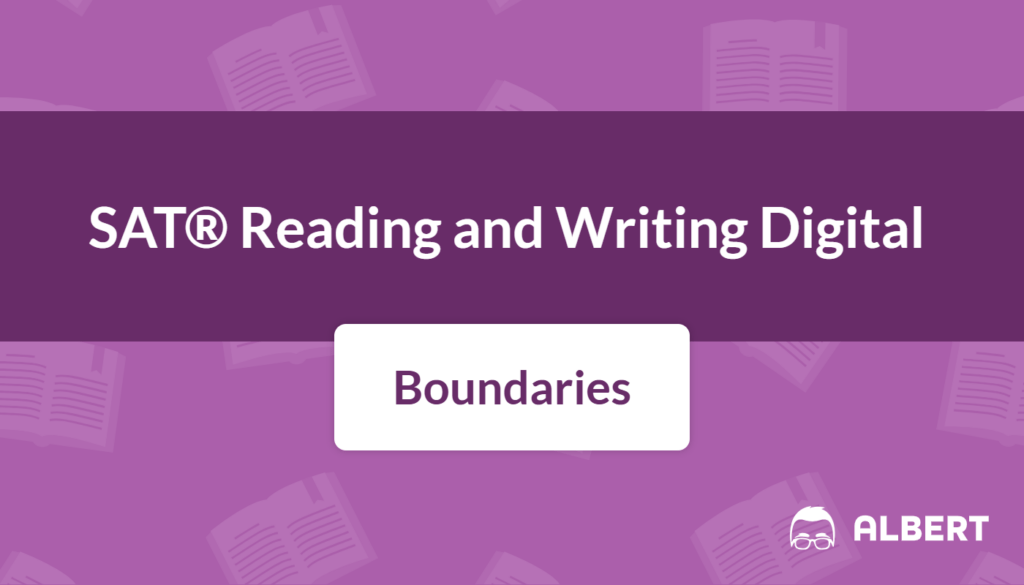What We Review
SAT® Punctuation Rules Study Guide
Punctuation plays a key role in clear and effective writing. On the SAT® Reading and Writing Test, correct punctuation, guided by SAT® Punctuation Rules, can help readers understand your ideas and show your mastery of English conventions. In addition, it helps avoid confusion in sentences.
This guide covers some of the most common punctuation marks, how to use them, and how to recognize common errors. Understanding these rules is important for both strong writing and SAT® success, especially on Boundaries questions.
Understanding Common Punctuation Marks
1. Commas (,)

Commas help separate ideas, items, or phrases. They also help prevent run-on sentences. Here are three common comma uses:
- Separating items in a list (e.g., apples, oranges, and bananas)
- Setting off introductory phrases (e.g., “After dinner, …”)
- Linking independent clauses with a coordinating conjunction (FANBOYS: For, And, Nor, But, Or, Yet, So)
However, comma usage can be tricky. One major error is the comma splice, which happens when two complete sentences are joined by only a comma.
Practice Sentence:
Sentence: “He loves soccer, he plays every weekend.”
Step-by-Step Solution:
1. Identify two complete thoughts:
- “He loves soccer.”
- “He plays every weekend.”
2. Notice that a simple comma connects these two independent clauses, creating a comma splice.
3. Fixing it:
- Use a period: “He loves soccer. He plays every weekend.”
- Use a coordinating conjunction: “He loves soccer, and he plays every weekend.”
- Use a semicolon: “He loves soccer; he plays every weekend.”
Choose the method that best fits your intended flow.
2. Semicolons (;)
A semicolon is often used to join closely related independent clauses. It can also help separate complex items in a list.
- Use a semicolon between two complete sentences that share a related idea.
- Place a semicolon before a transitional phrase like “however” or “therefore” when it joins two clauses.
Practice Sentence:
Sentence: “She completed all her assignments however she forgot to submit them.”
Step-by-Step Solution:
1. Identify the independent clauses:
- “She completed all her assignments.”
- “She forgot to submit them.”
2. Notice that a transitional word (“however”) appears between these clauses.
3. Correct the sentence:
- “She completed all her assignments; however, she forgot to submit them.”
Therefore, the semicolon provides a clear boundary between the two complete sentences.
3. Colons (:)
Use a colon after an independent clause to introduce a list, explanation, or quote. In addition, remember that the phrase before the colon must be a complete sentence.
Practice Sentence:
Sentence: “He only needed three things to succeed dedication, patience, and creativity.”
Step-by-Step Solution:
1. Identify the independent clause: “He only needed three things to succeed.”
2. Notice the list that follows: “dedication, patience, and creativity.”
3. Insert a colon after the complete thought:
- “He only needed three things to succeed: dedication, patience, and creativity.”
This rule is helpful for introducing important points.
4. Periods (.)
A period signals the end of a sentence. Incorrect use can lead to run-on sentences if there are not enough periods or to fragments if periods appear too early.
- A run-on sentence is created when two or more complete sentences run together without correct punctuation.
- A sentence fragment lacks a main clause or does not express a complete thought.
Practice Sentence:
Sentence: “They practiced for hours in the gym they had a big game the next day.”
Step-by-Step Solution:
1. Identify each complete thought:
- “They practiced for hours in the gym.”
- “They had a big game the next day.”
2. These two independent clauses need proper punctuation.
3. Correct the run-on by adding a period or using another method like a conjunction:
- “They practiced for hours in the gym. They had a big game the next day.”
5. Apostrophes (’)
Apostrophes show possession (John’s book) or join words in a contraction (it’s for “it is”). However, be sure that apostrophes are not placed in plural words unless showing possession.
Practice Sentence:
Sentence: “Its a shame that the teams uniforms were left behind.”
Step-by-Step Solution:
1. Check the contraction “Its.” If it means “it is,” use an apostrophe. If it shows possession, do not use an apostrophe.
2. In this sentence, “Its” should be “It’s” because it stands for “it is.”
3. For “teams uniforms,” a possessive is needed, so write “team’s uniforms.”
Correct version: “It’s a shame that the team’s uniforms were left behind.”
Punctuation in Complex Sentences
Complex sentences contain an independent clause and one or more dependent clauses. Commas often help separate these clauses and clarify meaning.
- Dependent clauses typically start with words like “when,” “because,” “although,” or “if.”
- Use a comma after a dependent clause if it comes before the main clause.
Practice Sentence:
Sentence: “Because they had studied diligently they passed the exam.”
Step-by-Step Solution:
1. Identify the dependent clause: “Because they had studied diligently.”
2. Identify the main clause: “They passed the exam.”
3. Notice that the dependent clause comes first, so place a comma after it: “Because they had studied diligently, they passed the exam.”
Recognizing and Correcting Sentence Errors
1. Run-On Sentences
A run-on sentence results from joining two or more complete sentences without proper boundaries. For example, “I enjoy reading it helps me to relax” is unclear.
How to fix:
- Separate clauses with a period.
- Use a coordinating conjunction (FANBOYS).
- Insert a semicolon.
Step-by-Step Example:
Sentence: “He struggled with math he decided to get tutoring.”
1. Two complete thoughts:
- “He struggled with math.”
- “He decided to get tutoring.”
2. Fix it:
- “He struggled with math, so he decided to get tutoring.”
- Or “He struggled with math. He decided to get tutoring.”
2. Comma Splices
A comma splice is a specific type of run-on. It uses only a comma to join two independent clauses.
How to fix:
- Add a coordinating conjunction.
- Replace the comma with a semicolon.
- Split into two sentences.
Step-by-Step Example:
Sentence: “She was late for practice, she apologized to the coach.”
1. Independent clauses:
- “She was late for practice.”
- “She apologized to the coach.”
2. Options to correct:
- “She was late for practice, so she apologized to the coach.”
- “She was late for practice; she apologized to the coach.”
3. Sentence Fragments
Fragments occur when a “sentence” lacks a subject or a main verb or does not express a complete idea. Often, fragments start with subordinating words like “while,” “because,” or “although” but never finish the thought.
How to fix:
- Add a main clause.
- Merge it with an existing sentence.
Step-by-Step Example:
Sentence: “Although he tried.”
- “Although he tried” is a dependent clause. It needs an independent clause to complete the thought.
- Combine it with a main sentence: “Although he tried, he could not finish on time.”
Essential SAT® Punctuation Rules to Remember
- Use commas with FANBOYS coordinating conjunctions to connect two complete ideas.
- For
- And
- Nor
- But
- Or
- Yet
- So
- Avoid comma splices by not using a single comma between two independent clauses.
- Use semicolons (;) between independent clauses or before transition words.
- Place colons (:) after an independent clause to introduce lists or explanations.
- Check for correct apostrophe usage in both contractions and possessives.
- Remember to end complete thoughts with a period and be aware of run-on sentences.
Practice Makes Perfect: SAT® Punctuation Rules
Regular SAT® punctuation practice helps build confidence. Here are some suggestions:
- Practice identifying independent and dependent clauses in sample passages.
- Check for proper punctuation boundaries using strategies mentioned above.
- Use official SAT® practice tests to get used to the test format.
Try this practice sentence:
“Sarahs team practiced daily however the other team only practiced once a week.”
- First, fix any apostrophe errors.
- Then, use correct punctuation for the transition word “however.”
- Make sure each clause stands alone if needed.
Step-by-Step Solution:
1. Correct “Sarahs” to “Sarah’s,” showing possession.
2. Split into independent clauses:
- “Sarah’s team practiced daily.”
- “The other team only practiced once a week.”
3. Combine with a semicolon and transition word:
“Sarah’s team practiced daily; however, the other team only practiced once a week.”
Now the sentence follows the proper punctuation rules.
Quick Reference Chart
Below is a quick list of important punctuation vocabulary and features:
| Term | Definition or Key Feature |
| Comma Splice | Error caused by using only a comma to join two independent clauses |
| Semicolon (;) | Joins related independent clauses; used before transition words like “however” |
| Colon (:) | Introduces a list or explanation after a complete thought |
| Apostrophe (’) | Shows possession (John’s book) or forms contractions (it’s = it is) |
| FANBOYS | Acronym for coordinating conjunctions: For, And, Nor, But, Or, Yet, So |
| Run-On Sentence | Occurs when two or more complete sentences are joined incorrectly |
| Fragment | An incomplete sentence lacking a subject, verb, or complete thought |
| SAT® Boundaries | Reminders to correctly use punctuation between clauses or sentences |
Conclusion
Mastering the SAT® Punctuation Rules is a big step toward stronger reading comprehension and writing skills. It allows sentences to be clear and easy to follow. This skill is important on the SAT® because it tests your ability to edit text and maintain correct boundaries between ideas.
When preparing for the test, continue to practice identifying clauses and applying the rules. With regular SAT® punctuation practice, it becomes easier to spot errors, correct them, and write confidently. Good luck on your journey towards success on the SAT® Reading and Writing Test!
Sharpen Your Skills for SAT® Reading and Writing
Are you preparing for the SAT® Reading and Writing test? We’ve got you covered! Try our review articles designed to help you confidently tackle real-world SAT® Reading and Writing problems. You’ll find everything you need to succeed, from quick tips to detailed strategies. Start exploring now!
- SAT® Grammar Rules: SAT® Reading and Writing Review
- Rhetorical Synthesis: SAT® Reading and Writing Review
- Transitions: SAT® Reading and Writing Review
Need help preparing for your SAT® Reading and Writing exam?
Albert has hundreds of SAT® Reading and Writing practice questions and full-length practice tests to try out.








